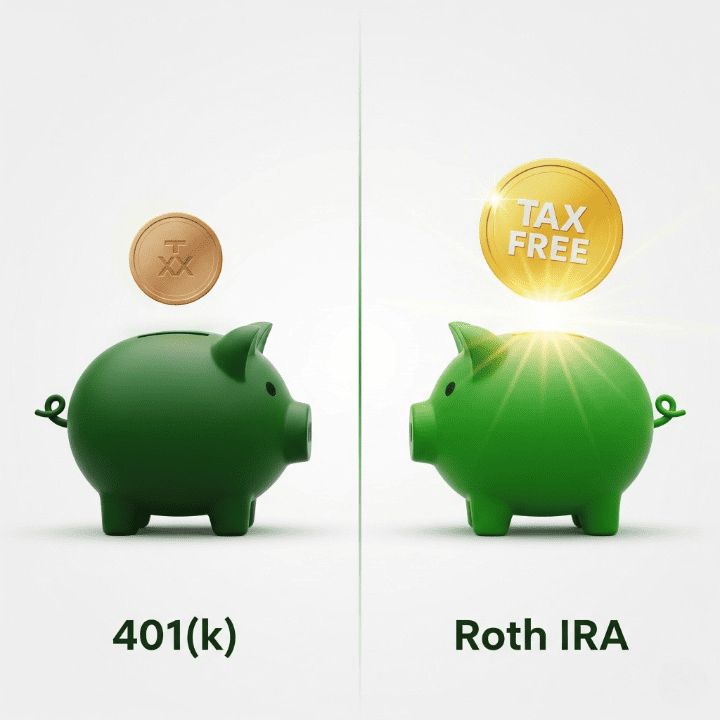
Introduction
Planning for retirement is one of the most significant financial journeys you will undertake. However, a confusing alphabet soup of account types often obscures the path: 401(k)s, IRAs, 403(b)s, and more. For many people, simply understanding the options is the biggest hurdle to getting started. Among this array of choices, the 401(k) and the Roth IRA stand out as two of the most powerful tools for building wealth. Both are designed to help you save for the future, but they operate under different rules, especially regarding taxes.
Making the right choice between these accounts can profoundly impact your nest egg and financial flexibility in retirement. One path offers an immediate tax break and potential “free money” from your employer. The other provides the powerful advantage of tax-free income when you need it most. This guide will break down the 401(k) vs. Roth IRA debate. We will clarify their core features, highlight key differences, and help you build a strategy that best suits your personal financial goals.
What is a 401(k)? The Employer-Sponsored Powerhouse
An employer sponsors a 401(k) plan, which is a type of retirement savings account. It lets workers save and invest a piece of their paycheck before the government takes out taxes. This is its most defining feature: pre-tax contributions. When you contribute to a traditional 401(k), the plan deducts the amount from your gross pay. This reduces your total taxable income for the year. For example, if you earn $60,000 and contribute $6,000, you will only pay income tax on $54,000 for that year. This provides an immediate, tangible tax advantage.
Your money then grows tax-deferred. This means you won’t pay any taxes on the interest, dividends, or capital gains your investments generate over the years. This process allows your nest egg to compound more rapidly than it would in a regular taxable account. You only pay taxes when you withdraw the money in retirement. Presumably, you may be in a lower tax bracket then than during your peak earning years.
Perhaps the most compelling feature of a 401(k) is the employer match. Many companies offer to match a certain percentage of your contributions as a benefit. For instance, a common match is “50% of the first 6% you contribute.” This means if you contribute 6% of your salary, your employer will add an additional 3% for free. This is essentially a guaranteed 50% return on your investment. Failing to contribute enough to get the full employer match is like turning down a pay raise.
What is a Roth IRA? The Power of Tax-Free Growth
A Roth IRA, or Individual Retirement Arrangement, is an account you open and fund on your own. It is completely separate from any employer. Its tax structure is the mirror image of a traditional 401(k). You contribute to a Roth IRA with post-tax dollars. This means you use money that the government has already taxed, so you get no immediate tax deduction for your contributions.
The true power of the Roth IRA reveals itself in retirement. Your investments grow completely tax-free. When you take the money out after age 59 ½, all your withdrawals are 100% tax-free. This is an incredibly powerful advantage. Imagine building a nest egg of $1 million. In a traditional 401(k), the IRS would tax every dollar you withdraw as ordinary income. In a Roth IRA, that entire $1 million is yours to keep, free from any tax obligations. This provides certainty in retirement, as you don’t have to worry about future tax rates.
However, you must be aware of the rules. The IRS sets limits on how much you can contribute each year, which are much lower than 401(k) limits. Furthermore, income restrictions apply. The government may prohibit high-income earners from contributing to a Roth IRA directly. Another key feature is its flexibility. You can withdraw your original contributions from a Roth IRA at any time, for any reason, without tax or penalty. This gives it a degree of flexibility other retirement accounts lack.
Key Differences: A Detailed Breakdown
Choosing between a 401(k) and a Roth IRA requires a clear understanding of their differences. Let’s compare them head-to-head on the factors that matter most.
Tax Treatment: The Pre-Tax vs. Post-Tax Dilemma
This is the most critical distinction.
- 401(k) (Traditional): Pre-tax contributions give you a tax break today. You pay taxes on your withdrawals in retirement. The core bet is that your tax rate will be lower in retirement.
- Roth IRA: Post-tax contributions mean no immediate tax break. Your withdrawals in retirement are completely tax-free. The core bet is that your tax rate will be higher in the future.
Contribution Limits and Income Restrictions
- 401(k): The IRS allows for very high annual contribution limits (over $20,000 for those under 50). No income restrictions apply.
- Roth IRA: Contribution limits are significantly lower (typically under $7,000 for those under 50). Additionally, the ability to contribute phases out for individuals who earn above a certain income threshold.
The Employer Match: A Decisive Advantage
- 401(k): Only 401(k) plans offer an employer match. This benefit is a form of free money that can dramatically accelerate your savings.
- Roth IRA: As an individual account, there is no employer match.
Investment Options and Flexibility
- 401(k): Your employer’s plan administrator limits your investment choices to a pre-selected menu of funds, usually mutual funds and target-date funds.
- Roth IRA: You have nearly limitless investment options. You can open a Roth IRA at a brokerage and invest in stocks, bonds, ETFs, and more, giving you complete control.
Withdrawal Rules and Penalties
- 401(k): Withdrawing money before age 59 ½ typically results in a 10% penalty plus ordinary income tax, though some exceptions exist.
- Roth IRA: You can withdraw your direct contributions at any time, tax-free and penalty-free. However, withdrawing earnings before age 59 ½ will generally incur taxes and a penalty.
401(k) vs. Roth IRA: Which One Should You Prioritize?
For most people, this is not an “either/or” decision. Instead, it is a question of prioritization. The optimal strategy depends on your personal circumstances.
Priority #1: Maximize the 401(k) Employer Match Before anything else, contribute enough to your 401(k) to get the full employer match. This is a 50% or 100% guaranteed return on your money. You cannot get this return anywhere else, so not taking advantage of it is a significant financial mistake.
Priority #2: Consider Your Tax Situation After securing the match, the decision becomes more nuanced.
- You expect a higher tax bracket in the future: If you are early in your career and anticipate salary growth, paying taxes now via a Roth IRA may be wise. This locks in today’s lower tax rate.
- You are in your peak earning years: If you are in a high tax bracket now, the immediate tax deduction from a 401(k) is very valuable. This is a good choice if you expect to be in a lower tax bracket in retirement.
Priority #3: Fund a Roth IRA to its Limit Many financial planners suggest funding a Roth IRA to the max after securing your 401(k) match, if you are eligible. The greater investment flexibility and tax-free withdrawals provide valuable tax diversification.
Priority #4: Go Back to Your 401(k) If you have maxed out your Roth IRA and still have money to save, return to your 401(k). Contribute as much as you can up to the federal limit. The “why not both?” strategy is often the most effective way to build a robust retirement portfolio.
Conclusion
The 401(k) and Roth IRA are both exceptional tools for building long-term wealth. However, they serve different strategic purposes centered around their tax treatment. The 401(k) is an employer-sponsored plan offering an immediate tax deduction and the unparalleled benefit of an employer match. It is the workhorse of retirement savings, letting you lower your tax bill today while your investments grow tax-deferred.
The Roth IRA, on the other hand, is an individual account that plays the long game. By forgoing a tax break today, you purchase something incredibly valuable for your future self: a stream of completely tax-free income in retirement. For most people, the ideal path is a strategic combination of both. By first capturing your full employer match in a 401(k) and then funding a Roth IRA, you can harness the unique strengths of each account. This balanced approach provides tax diversification, flexibility, and a powerful engine for growth, paving the way for a secure and prosperous retirement.



